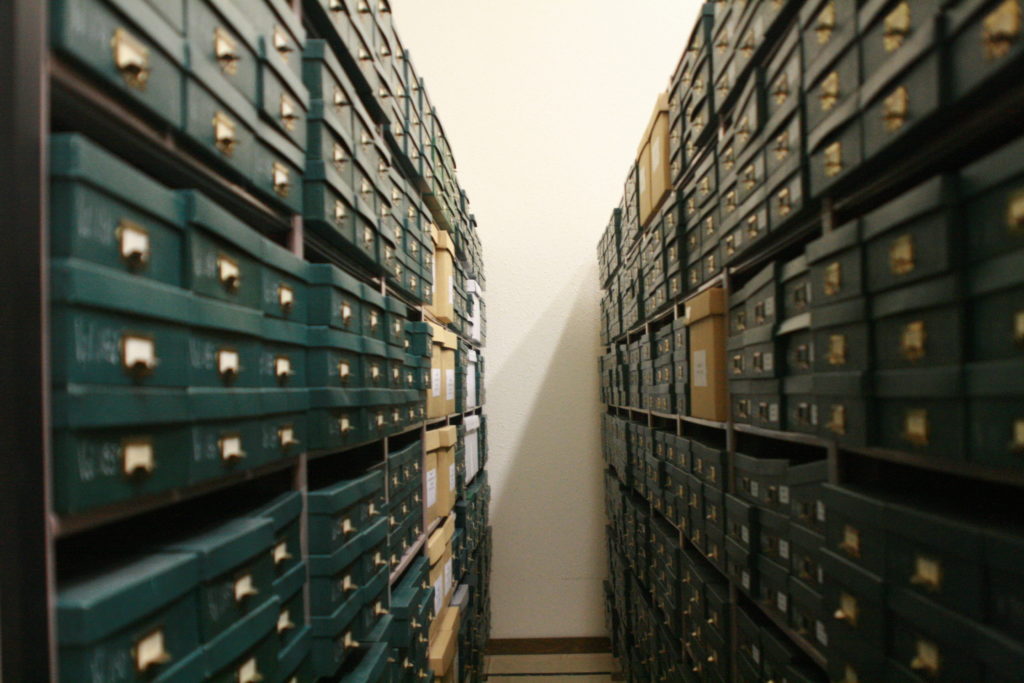- Congregational Historian
- What should be kept?
- Importance of Writing Good Minutes
- Bringing the Past Into the Present
Congregational Historian
The congregational historian is a key person in maintaining the memory of the congregation and its participants. In some churches the Historian can work closely with other “record keepers” such as the administrative assistant and/or pastor.
Churches should appoint a person who is responsible to:
- collect historically significant data and documents
- submit the collected and organized materials to the archives
- promote the collection and submission of historical documents from church participants to a recognized archives.
- Some congregational historians may see a need to be more proactive and help create historical records such as oral histories.
A good Congregational Historian is a person who…
- Is interested in history
- Can keep materials organized
- Is active in the congregation
Tasks includes:
- Collecting all committee minutes, bulletins, annual reports, budget and submitting them to the archives.
- Keeping an eye open for historically significant materials when congregational members are downsizing or have died. Rather than the materials being discarded, they may be valuable to the archives.
- Continuing education. Helping the church with anniversaries, writing of congregational histories etc.
What should be kept?
Records of the past are kept because they’re able to wrench us out of our present comfort – or pain – and tell us the story of how we got here. They remind us of decisions, people, and a God who continues to be faithful. Stories of the past give us courage and vision for the future.
Many congregations find it difficult to know what to save, and how to save it. A fulsome resource is David Haury’s Heritage Preservation: A Resource Book for Congregations.
In summary, congregations should keep:
- Vital records such as membership, baptism, and cemetery registers.
- Legal papers such as deeds, mortgages, constitutions, and bylaws.
- Records of organization such as minutes and correspondence from church committees and other groups. Minutes should record decisions and discussions leading up to them.
- Publications by and about the church and its members such as newsletters, bulletins, and relevant articles in community newspapers.
- Ministerial materials such as sermons, correspondence, and important emails.
- A Selection of worship service recordings.
- Special records such as photos, oral histories, family papers and genealogies, community histories, videos, and recordings of special events should also be kept.
- It’s important to remember that some records will be sensitive or confidential in nature. Congregations should restrict access to some records to protect people, but not necessarily destroy. This might include allowing only certain people to look at the information, prohibiting duplication of the material, or closing files for a certain number of years. In consultation with the archivist an appropriate approach can be agreed upon.
What is usually not kept?
- Duplicates
- Drafts
- Routine correspondence
- Equipment manuals
- Receipts, cancelled checks, invoices
Importance of Writing Good Minutes
Writing minutes can be a thankless job but it is a very important task.
Minutes help remind people:
- what was discussed
- what was decided
- next steps to be taken by whom.
If minutes are not taken:
- tasks get forgotten
- people drop out of the project
- issues get talked about over and over without progress.
Minutes help move people and projects on the path to the goal.
When you are writing minutes you should:
- Consider incorporating a numbering system. This helps keep track of the minutes and it is easier to know if a set of minutes is missing. An example is the year following by a sequential number eg. 2020-01.
- Name of organization and committee
- Date of the meeting
- Full name of people present
- Full name of people absent
- If there is an agenda, use it to help you organize your minutes.
- Record the essence of the discussion along with the decision made and add names of people who are responsible for carrying out the decision.
Example Minutes:
Minutes 2020-11
Mennonite Church of Plum Coulee
Sunday School Committee Meeting
April 31, 2020, 10am
Present: John Friesen, Sara Dyck, Helen Klassen, Gerhard Wiebe
Regrets: David Enns, Susan Zacharias
- John opening the meeting with a prayer.
- Sara reviewed last minutes. They were accepted as presented.
- Sunday School
- Curriculum – There was a discussion about which material to use. Cost, theological emphasises, teacher helps, were all key factors. Helen agreed to do some research and present option sot the committee at the next meeting.
- Sunday School Teacher Appreciation Event – there was a lengthy discussion about where to have the event. Options included at the church, in the park, or simply as part of the worship service. It was decided to have the event after the church service on the church grounds so that if the weather was not good, we could still have the event indoors.
- Next meeting May 15, 2020, 10 am at the church.
- Minutes recorded by Sara Dyck.
Bringing the Past into the Present
Creative ways for churches to remember their history
What is the first thing that comes to mind when someone talks about recognizing a congregational anniversary? Often a history book comes to my mind. While these projects can provide an in-depth and complex investigation of the church, its members, and activities – all within its local context. But congregational history books can be long and involved projects that can spend a lot of time on a shelf. Another fall back idea is a website or webpages within the congregational website. While another valuable contribution, usually it is only people specifically looking for historical information who will visit the site. However, finding ways to display the congregation’s history around the building educates more people in a more organic way. What are some other ways congregations can recognize and educate people about its past.
Here are a few suggestions:
- Display Photos
- Of the pastors of the congregation from past years with their years of service like Zoar Mennonite Church.
- Of baptism classes with all the people identified like Sargent Avenue Mennonite Church in Winnipeg.
- In a display cabinet, along with artifacts, where a volunteer curator can create themed displays with borrowed materials from church members. Possible themes could be graduations, hobbies, anniversaries, travels, thankfulness, etc.
- Create
- A world map with pins representing who, where, and when church members served around the world with relieve agencies, on mission’s trips, etc. Add the map to the congregational website and create an interactive feature if applicable.
- A congregational timeline that could include things such as pastors and their years of service, membership numbers, changes to the building, growth of new programs, etc. Adding extra lines representing community, national, or international events helps put these congregation events in context.
- A time capsule that will be opened in several decades.
- An installation of art, a quilt, stained glass windows, pottery, paintings which incorporates aspects of the congregation’s past. Bethel Mennonite Church in Winnipeg, has an art instillation that incorporates a time capsule. Read more about Bethel’s art installation here.
- Plaque or Sign
- Commemorating a significant list of people like Bethel Mennonite Church in Winnipeg which has a plaque listing people who served as conscientious objectors in the Second World War.
- Commemorating a significant event in the life of the church. For the Altona Bergthaler Mennonite Church it was the visit of the Governor General of Canada’s visit to the congregation.
- Erb Street Mennonite Church in Waterloo has small signs around the congregations with text and photos giving snippets of historical information such as when they hosted of Mennonites refugees from Russia in 1924. Other signs on the stairwell to the nursery reveal the discussion of whether the church should have a nursery or a storage area and how a deacon in the church wanted to make the building more accessible for themselves and others lead the construction of an enclosed ramp into the building.

A plaque with photograph and historical details that hangs in Erb Street Mennonite Church in Waterloo, ON. 
A sign commemorating an event at Erb Street Mennonite Church in Waterloo, ON.
- Share Stories
- By compiling life stories of congregational members who have passed away. Research may need to be done for those who have passed away longer ago. Obituaries in local newspapers are key sources as well as congregational cemeteries.
- In Sunday School by inviting someone from another congregation to speak about their congregation. Invite them to touch on the church’s history, growth, challenges, and future.
- Through supporting an oral history project among the congregation. This can be a rich well of stories that often do not find their way into official history books. It can also be a rich store house of information for future historical projects. Contact your local historical society or the Mennonite Heritage Archives for suggestions of things to consider.
- In Worship
- Incorporate stories and lessons from the congregational and denominational history as part of the sermon and children’s features. Checking out the congregational and denomination history books can be a huge help. There are numerous books featuring bite-sized stories from Mennonite history. For example: Zweibach Trail by Lisa Weaver, Julie Kauffman, and Judith Rempel Smucker or City of Refuge: Stories from Anabaptist-Mennonite History and Life by Harry Loewen. For a longer list see the Other Resources page on our website.
- Plan a “how it used to be” service. Worshipping in the forms of the past can be deeply instructive. The order of service, the songs sung, the format of the sermon, the language of service, where people sat, may all have changed. How did the church worship 100 years ago, 50 years ago, 20 years ago?
- Commemorate Mennonite Heritage Sunday each year. Resources available here.
- Support
- Local History organizations by offering up the church as a free space for meetings and initiatives.
- Congregational history by creating a congregational historian position. This person will collect historically significant materials recording the church’s history so that when the church wants to consider its past, there are records to consult. For more information, see the “Congregational Historian” section on this page, “For Churches.”
- Your denominational archives. These memory institutions are vital to the church, denomination, and the wider community. Offer your records for safe keeping and offer support in the way of prayer for staff, volunteers, as well as provide financial contributions when appropriate.


